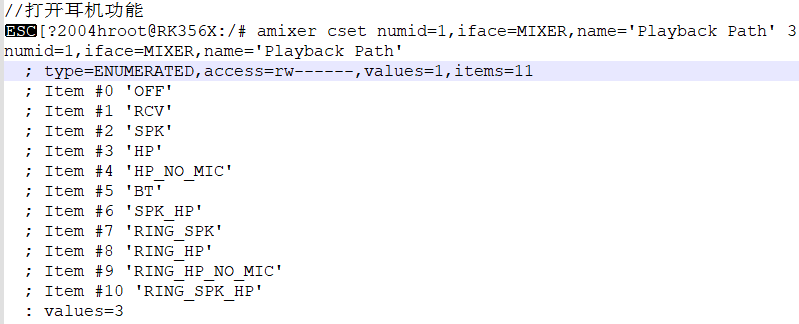Linux alsa 音频 录制与播放
一. 概述
ALSA是Advanced Linux Sound Architecture 的缩写,目前已经成为了linux的主流音频体系结构。
在内核设备驱动层,ALSA提供了alsa-driver,同时在应用层,ALSA为咱们提供了alsa-lib,应用程序只要调用alsa-lib提供的API,便可以完成对底层音频硬件的控制。
二.常用命令
aplay -l 显示实际声卡序号
查看声卡:
cat /proc/asound/cards录音:
arecord -D hw:0,0 -c 2 -r 44100 -f S16_LE test.wav播放:
aplay -Dplughw:0,0 test.wav打开耳机功能
amixer cset numid=1,iface=MIXER,name='Playback Path' 3打开MIC(麦克风)功能:
amixer cset numid=2,iface=MIXER,name='Capture MIC Path' 1三.音频参数理解
声道
单声道:mono
双声道:stereo。最常见的类型,包含左声道以及右声道
采样率
音频采样,是把声音从模拟信号转换为数字信号。采样率,就是每秒对声音进行采集的次数,同样也是所得的数字信号的每秒样本数
采样越高,声音的还原就越真实越自然,人对频率的识别范围是 20HZ - 22000HZ, 如果每秒钟能对声音做 22000 个采样, 回放时就足可以满足人耳的需求. 所以 22050 的采样频率是常用的, 根据奈奎斯特采样定理44100Hz是不失真的情况下的采样率, 超过48000的采样对人耳已经没有意义。
四.用户空间打开PCM设备录制声音
#define ALSA_PCM_NEW_HW_PARAMS_API
#include
int main() {
long loops;
int rc;
int size;
unsigned int val;
int dir;
char *buffer;
snd_pcm_t *handle;
snd_pcm_hw_params_t *params;
snd_pcm_uframes_t frames;
/*以录制模式打开*/
/* Open PCM device for recording (capture). */
rc = snd_pcm_open( &handle, "default", SND_PCM_STREAM_CAPTURE, 0);
if (rc < 0) {
fprintf(stderr, "unable to open pcm device");
exit(EXIT_FAILURE);
}
/*分配一个参数对象*/
/* Allocate a hardware parameters object. */
snd_pcm_hw_params_alloca(¶ms);
/*初始化参数对象*/
/* Fill it in with default values. */
rc = snd_pcm_hw_params_any(handle, params);
if (rc < 0) {
printf("Err\n");
}
/* Set the desired hardware parameters. */
/*交错模式*/
/* Interleaved mode */
rc = snd_pcm_hw_params_set_access(handle, params,
SND_PCM_ACCESS_RW_INTERLEAVED);
if (rc < 0) {
printf("Err\n");
}
/*PCM格式*/
/* Signed 16-bit little-endian format */
rc = snd_pcm_hw_params_set_format(handle, params,
SND_PCM_FORMAT_S16_LE);
if (rc < 0) {
printf("Err\n");
}
/*设置通道数*/
/* Two channels (stereo) */
rc = snd_pcm_hw_params_set_channels(handle, params, 2);
if (rc < 0) {
printf("Err\n");
}
/*设置采样率*/
/* 44100 bits/second sampling rate (CD quality) */
val = 44100;
rc = snd_pcm_hw_params_set_rate_near(handle, params,
&val, &dir);
if (rc < 0) {
printf("Err\n");
}
/*没周期的帧数*/
/* Set period size to 32 frames. */
frames = 32;
rc = snd_pcm_hw_params_set_period_size_near(handle,
params, &frames, &dir);
if (rc < 0) {
printf("Err\n");
}
/* Write the parameters to the driver */
rc = snd_pcm_hw_params(handle, params);
if (rc < 0) {
fprintf(stderr,
"unable to set hw parameters: %s/n",
snd_strerror(rc));
exit(1);
}
/* Use a buffer large enough to hold one period */
rc = snd_pcm_hw_params_get_period_size(params,
&frames, &dir);
if (rc < 0) {
printf("Err\n");
}
size = frames * 4; /* 2 bytes/sample, 2 channels */
buffer = (char *) malloc(size);
/* We want to loop for 5 seconds */
rc = snd_pcm_hw_params_get_period_time(params, &val, &dir);
loops = 5000000 / val;
while (loops > 0) {
loops--;
rc = snd_pcm_readi(handle, buffer, frames);
if (rc == -EPIPE) {
/* EPIPE means overrun */
fprintf(stderr, "overrun occurred/n");
//把PCM流置于PREPARED状态,这样下次我们向该PCM流中数据时,它就能重新开始处理数据。
snd_pcm_prepare(handle);
} else if (rc < 0) {
fprintf(stderr,
"error from read: %s/n",
snd_strerror(rc));
} else if (rc != (int)frames) {
fprintf(stderr, "short read, read %d frames/n", rc);
}
rc = write(1, buffer, size);
if (rc != size)
fprintf(stderr,
"short write: wrote %d bytes/n", rc);
}
//调用snd_pcm_drain把所有挂起没有传输完的声音样本传输完全
rc = snd_pcm_drain(handle);
//关闭该音频流,释放之前动态分配的缓冲区,退出
rc = snd_pcm_close(handle);
free(buffer);
return 0;
} 五.用户空间打开PCM设备播放声音
#define ALSA_PCM_NEW_HW_PARAMS_API
#include
int main() {
long loops;
int rc;
int size;
snd_pcm_t *handle;
snd_pcm_hw_params_t *params;
unsigned int val;
int dir;
snd_pcm_uframes_t frames;
char *buffer;
/* Open PCM device for playback. */
rc = snd_pcm_open(&handle, "default",
SND_PCM_STREAM_PLAYBACK, 0);
if (rc < 0) {
fprintf(stderr,
"unable to open pcm device: %s/n",
snd_strerror(rc));
exit(1);
}
/*分配一个参数对象*/
/* Allocate a hardware parameters object. */
snd_pcm_hw_params_alloca(¶ms);
/*初始化参数对象*/
/* Fill it in with default values. */
snd_pcm_hw_params_any(handle, params);
/* Set the desired hardware parameters. */
/*交错模式*/
/* Interleaved mode */
snd_pcm_hw_params_set_access(handle, params,
SND_PCM_ACCESS_RW_INTERLEAVED);
/*设置PCM格式*/
/* Signed 16-bit little-endian format */
snd_pcm_hw_params_set_format(handle, params,
SND_PCM_FORMAT_S16_LE);
/*设置通道数*/
/* Two channels (stereo) */
snd_pcm_hw_params_set_channels(handle, params, 2);
/*设置采样率*/
/* 44100 bits/second sampling rate (CD quality) */
val = 44100;
snd_pcm_hw_params_set_rate_near(handle, params,
&val, &dir);
/* Set period size to 32 frames. */
frames = 32;
snd_pcm_hw_params_set_period_size_near(handle,
params, &frames, &dir);
/* Write the parameters to the driver */
rc = snd_pcm_hw_params(handle, params);
if (rc < 0) {
fprintf(stderr,
"unable to set hw parameters: %s/n",
snd_strerror(rc));
exit(1);
}
/* Use a buffer large enough to hold one period */
snd_pcm_hw_params_get_period_size(params, &frames, &dir);
size = frames * 4; /* 2 bytes/sample, 2 channels */
buffer = (char *) malloc(size);
/* We want to loop for 5 seconds */
snd_pcm_hw_params_get_period_time(params,
&val, &dir);
/* 5 seconds in microseconds divided by
* period time */
loops = 5000000 / val;
while (loops > 0) {
loops--;
rc = read(0, buffer, size);
if (rc == 0) {
fprintf(stderr, "end of file on input/n");
break;
} else if (rc != size) {
fprintf(stderr,
"short read: read %d bytes/n", rc);
}
rc = snd_pcm_writei(handle, buffer, frames);
if (rc == -EPIPE) {
/* EPIPE means underrun */
fprintf(stderr, "underrun occurred/n");
//把PCM流置于PREPARED状态,这样下次我们向该PCM流中数据时,它就能重新开始处理数据。
snd_pcm_prepare(handle);
} else if (rc < 0) {
fprintf(stderr,
"error from writei: %s/n",
snd_strerror(rc));
} else if (rc != (int)frames) {
fprintf(stderr,
"short write, write %d frames/n", rc);
}
}
//调用snd_pcm_drain把所有挂起没有传输完的声音样本传输完全
snd_pcm_drain(handle);
//关闭该音频流,释放之前动态分配的缓冲区,退出
snd_pcm_close(handle);
free(buffer);
return 0;
} 


